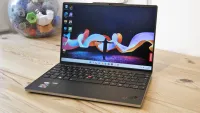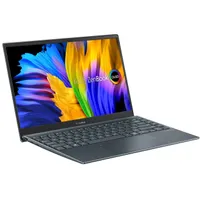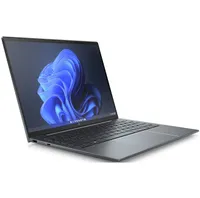TechRadar Verdict
This laptop begs to ask the question of why you might want Windows 11 if you can’t run all Windows applications. There are some reasons, but there are just as many for running Linux or using a Chromebook. Amazing battery life is available for those willing to embrace this hybrid concept.
Pros
- +
Lightweight
- +
Next-level battery life
- +
Dual NVMe slots
Cons
- -
Two USB-C ports
- -
ARM platform won’t run all apps
- -
Expensive
Why you can trust TechRadar
Lenovo ThinkPad X13s: Two minute review
On the outside, this machine is almost identical to the Lenovo ThinkPad Z13, with the main difference being that this model is constructed from reclaimed magnesium and finished in black.
There are some external differences, especially in respect of the touchpad, but these are minor compared with the radical alterations hidden inside this laptop.
While the Z13 used an AMD Ryzen processor, and Lenovo makes similar designs that use 12th Gen Intel platforms, the X13s uses neither of these options.
At the heart of this machine is a Qualcomm Snapdragon 8cx Gen 3 Compute Platform, silicon based on the ARM technology that is popular in phones and tablets.
This is an eight-core CPU clocked at up to 3GHz, and here it runs an ARM version of Windows 11 Pro.
Not being x86 compliant, this version of Windows relies on emulation to run Windows apps. According to Microsoft, “Windows on Arm runs native Arm apps, as well as many unmodified x86 & x64 apps, but for the best performance and battery life, apps should be built to be Arm-native wherever possible.”
Therefore the devil of this detail is in the word ‘many’. Because in our tests, some older x64 applications didn’t run, although sometimes this was down to the lack of GPU technology, not the processor.
Sign up to the TechRadar Pro newsletter to get all the top news, opinion, features and guidance your business needs to succeed!
For those running native compiled ARM Windows applications, the performance is comparable with a low-end AMD or Intel processor, and the battery life of the x13s is extensive.
Lenovo quotes an implausibly long 28 hours of standard use and 49.5 hours of video playback from the modest 49.5Whr battery.
Therefore what the X13s delivers is a slightly compromised system that will deliver extended battery life if you are willing to work with its platform limitations.
It also, for reasons that only Lenovo understand, only comes with USB-C ports and not the Type-A that most people still use for connecting external drives, mice and keyboards.
The ThinkPad X13s is a long way from the rather sad ARM-based Surface machines that Microsoft once offered, but it’s still not a PC in the purest sense, and those wanting to play games or run CAD should steer clear of it.
It’s also on the expensive end of the price range for ARM-based machines.
Lenovo ThinkPad X13s: Price and availability

- How much does it cost? From $994.95 / £1,479.99/ AU$ 1,795.59
- When is it out? It is available now
- Where can you get it? You can get it directly from Lenovo in all regions
Here is the Lenovo ThinkPad X13s configuration sent to TechRadar for review:
CPU: Qualcomm Snapdragon 8cx Gen 3 SC8280XP Processor
Graphics: Qualcomm Adreno 690
RAM: 16GB LPDDR4x (Soldered)
Screen: 13.3" WUXGA (1920 x 1200) IPS
Storage: 256 GB SSD PCIe
Ports: 2x USB Type-C, Headphone/mic combo
Connectivity: Qualcomm Wi-Fi 6E WCN6855 2x2 AX; Bluetooth 5.1, X55 5G Sub6 Modem-RF System
Camera: 5MP RGB with webcam privacy e-shutter
OS: Windows 11 Pro for ARM
Weight: 1.06kg
Size: 13.4mm x 298.7mm x 206.4mm (W x D x H)
Battery: 49.5Wh 4-cell Lithium-ion Battery with 65W AC Adaptor
Again we see a vast discrepancy between what US customers pay for the entry-level ThinkPad X13s and the price European and Australian customers might experience.
However, the US first rung SKU has 8 GB of RAM and 256GB of storage, whereas the only UK and Australian SKUs have 16GB and 256GB of SSD space.
That doesn’t make up for the price difference, but to get 16GB of RAM in the USA requires buying a model that costs at least $1,301.40, making the cost closer to other regions.
The top US SKU is priced at $1,571.40, comes with 16GB of RAM and 1TB SSD, and a Qualcomm Snapdragon X55 5G Sub 6 WWAN module. UK and Australian customers don’t have an option for WWAN yet, but we expect Lenovo to add an SKU with this feature.
Customers should note that the RAM in these machines is soldered in place, so buying an 8GB or 16GB model and then upgrading it to 32GB isn’t possible, unfortunately.
- Value: 4 / 5
Lenovo ThinkPad X13s: Design

- Magnesium construction
- Lacks privacy camera cover
- 1920 x 1200 screen
Essentially the same shape and almost the same size, but slightly lighter than the Z13. This casing is anodised black magnesium and looks very business-like. The underside feels like plastic, but security labels obstructed us from unscrewing it to find out for certain.
This finish doesn’t attract fingerprints like some of the ThinkPad coatings, thankfully.
Opening the case, compared to the Z13, the X13s has a narrower keyboard providing space down the sides for two Dolby Audio spec speakers.
This keyboard looks like it was borrowed from one of the cheaper Lenovo laptops and not the higher-specification designs. This reviewer found it squishy and not ideal for the highest-speed typing, but it's workable for less demanding typists, and it is spillage resistant.
Whereas other ThinkPads have a dedicated key for the fingerprint scanner, on the X13s, the power button does double duty for scanning fingers.
Whereas on other Z and X series ThinkPad designs, greater resolutions are available, on the X13s are three screen options, and they are all 1920 x 1200 resolution.
Our review hardware sported the basic IPS with an antiglare coating and a brightness of 300nits. Options exist for a touch version of this screen and an enhanced low-power panel that is marginally brighter at 400 nits and is also Eyesafe certified.
The screen is sharp and well-saturated, and the coating avoids the sorts of reflections that can make a laptop difficult to use in daylight.

Above the screen is a 5MP RGB webcam with a privacy e-shutter. Not sure we really get why an e-shutter is a better choice than a physical one. A physical obstruction can’t be circumvented merely by inserting a key press into the input buffer. But that’s what it has.
As with the display, Lenovo has options for alternatives to this camera that offer IR functionality needed to operate Windows Hello or other identification security protocols.
The one slightly controversial feature that it shares with the Z13 is that the only USB ports are USB-C, and one of them is required for charging.
The hint, if you didn’t get it, is that a USB-C hub or docking station is required for those wanting to use more than one peripheral with their X13s.
- Design: 4 / 5
Lenovo ThinkPad X13s: Features
- Fanless
- Soldered memory
- Dual 2242 M.2 Ports
With Apple showing how reworked ARM technology can work in the personal computer space with the M1 hardware, now PC makers are considering the same evolution.
This power consumption is low enough that the X13s doesn’t require a fan to stay cool, making it entirely silent when running.
Even being ARM-based, this is a powerful CPU. If this has a weakness, the Adreno GPU isn’t at the same level as those generally found on an x86 machine when asked to generate 3D images or compute calculations.
There are other issues to do with running a version of Windows that isn’t x86/64, but we’ll get to those implications in good time.
Essentially, if you ignore the x86 elephant in this room, this is a reasonably specified computer that is highly efficient with power.
However, as appears to now be a thing with Lenovo laptops, the memory is soldered to the mainboard making memory upgrades impossible.
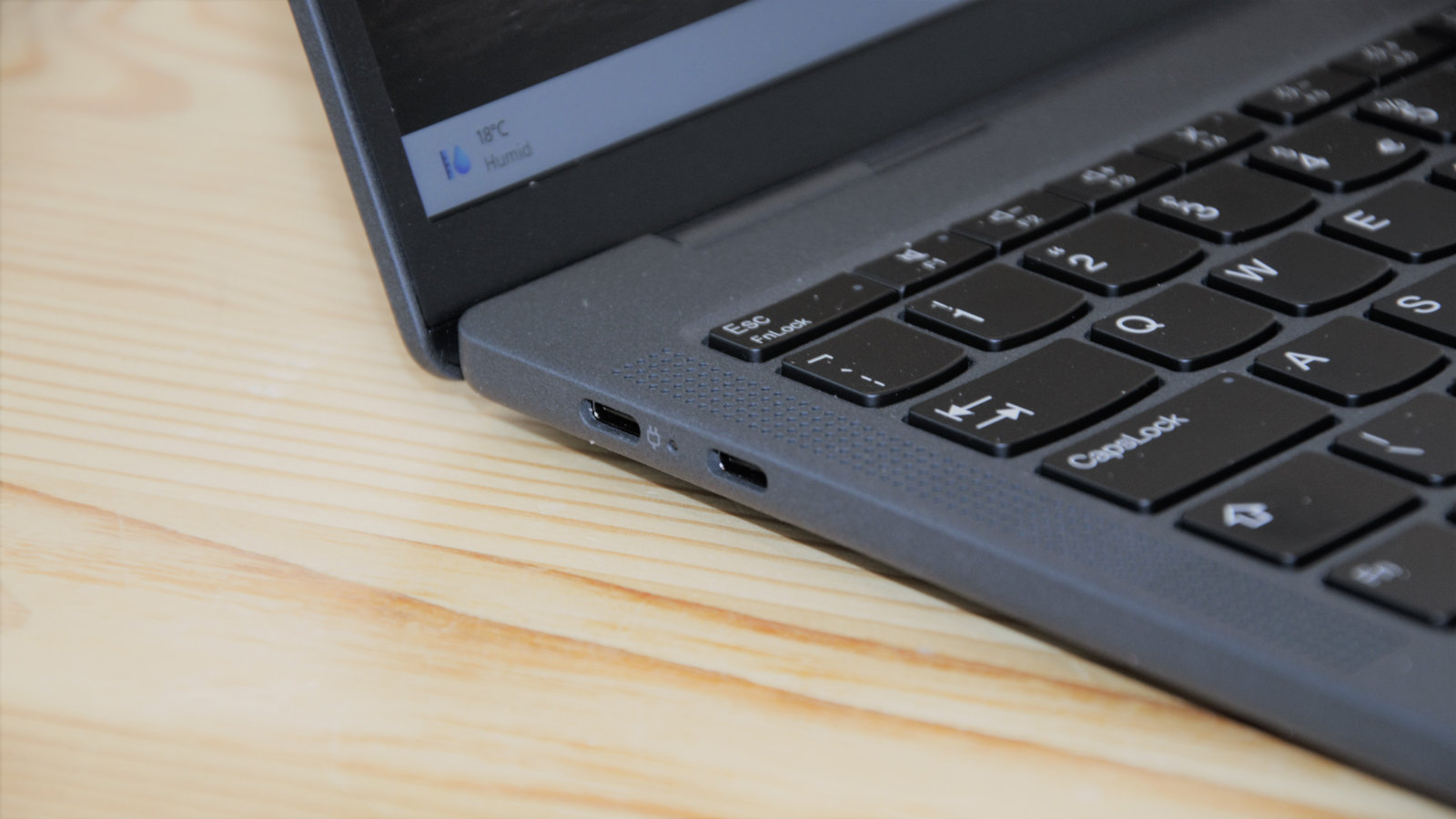
If you are prepared to remove the seal sticker and unscrew the underside, this still won't allow you to change whatever RAM it had when purchased.
What can be adjusted by ignoring the sticker is the NVMe storage, as by default only one of the NVMe M.2 slots is occupied in most SKUs from the factory.
The snag to this remarkably helpful option is that these M.2 slots are 2242 spec, not the typical 2280 that desktop systems and game consoles use.
While modules of this size are generally available, they tend to offer a maximum of 1TB of storage and do not deliver the full performance of the PCIe 4.0 interface.
Should larger capacities become available, and with NAND density increasing, that seems likely, this machine is well placed for cloning the system to a bigger drive. Although, we didn’t test any of the typical cloning tools to see if they would run on this Windows release.
- Features: 4 / 5
Lenovo ThinkPad X13s: Performance
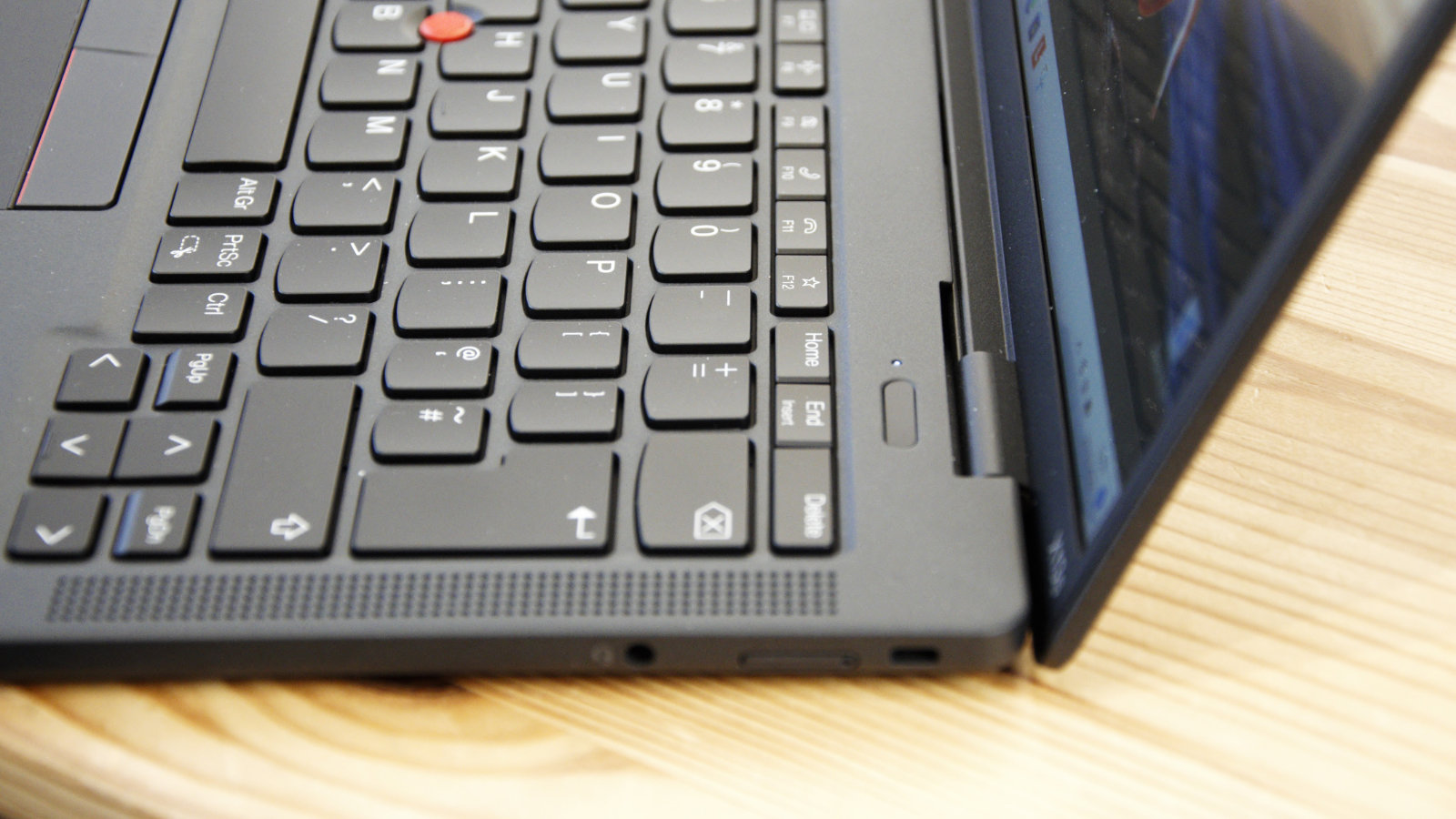
- Won’t run all apps
- Surprisingly quick
- Beyond amazing battery life
Here's how the Lenovo ThinkPad X13s scored in our suite of benchmark tests:
3DMark Wild Life:N/A; Fire Strike: 2,772; Time Spy: 901
Cinebench R23 CPU: 530(single-core); 2,720 (multi-core)
GeekBench 5: 1,099 (single-core); 5,807 (multi-core), N/A (OpenCL)
CrystalDiskMark: Sequential Read: 3,170 MB/s; Sequential Write: 1,703MB/s
PCMark 10: N/A
PCMark 10 Battery Life (Modern Life): N/A
Windows Experience Index: N/A
Overall, we’d judge the X13s as being suitable for light-duty office work, assuming the applications work either natively or in emulation mode, but it has a dramatic advantage when it comes to battery life.
When we got to the testing stage, we ran headlong into the practical limitations of Windows 11 Pro for ARM. In short, it won’t run some applications. These issues exist because the software does something in x64 code that isn’t emulated or because the Adreno 690 GPU wasn’t designed to be a PC graphics sub-system and doesn’t support the required features.
Under 3DMark Wild Life wouldn’t run, the GeekBench Compute test didn’t have the required hardware, and none of our PCMark 10 tools would function.
When the tests did run, the numbers they returned were equivalent to our expectations for a very low-specification PC, with the possible exception of the CrystalDiskMark scores.
At its best, the X13s was about 60% of the power of the AMD Ryzen 5 in the Z13 or half the speed of the Intel Core i7-1260P in the X1 Carbon.
That’s on par with lacklustre 11th Gen Intel hardware, but it represents a major improvement over the 8CX Gen 2 version of this Snapdragon series.
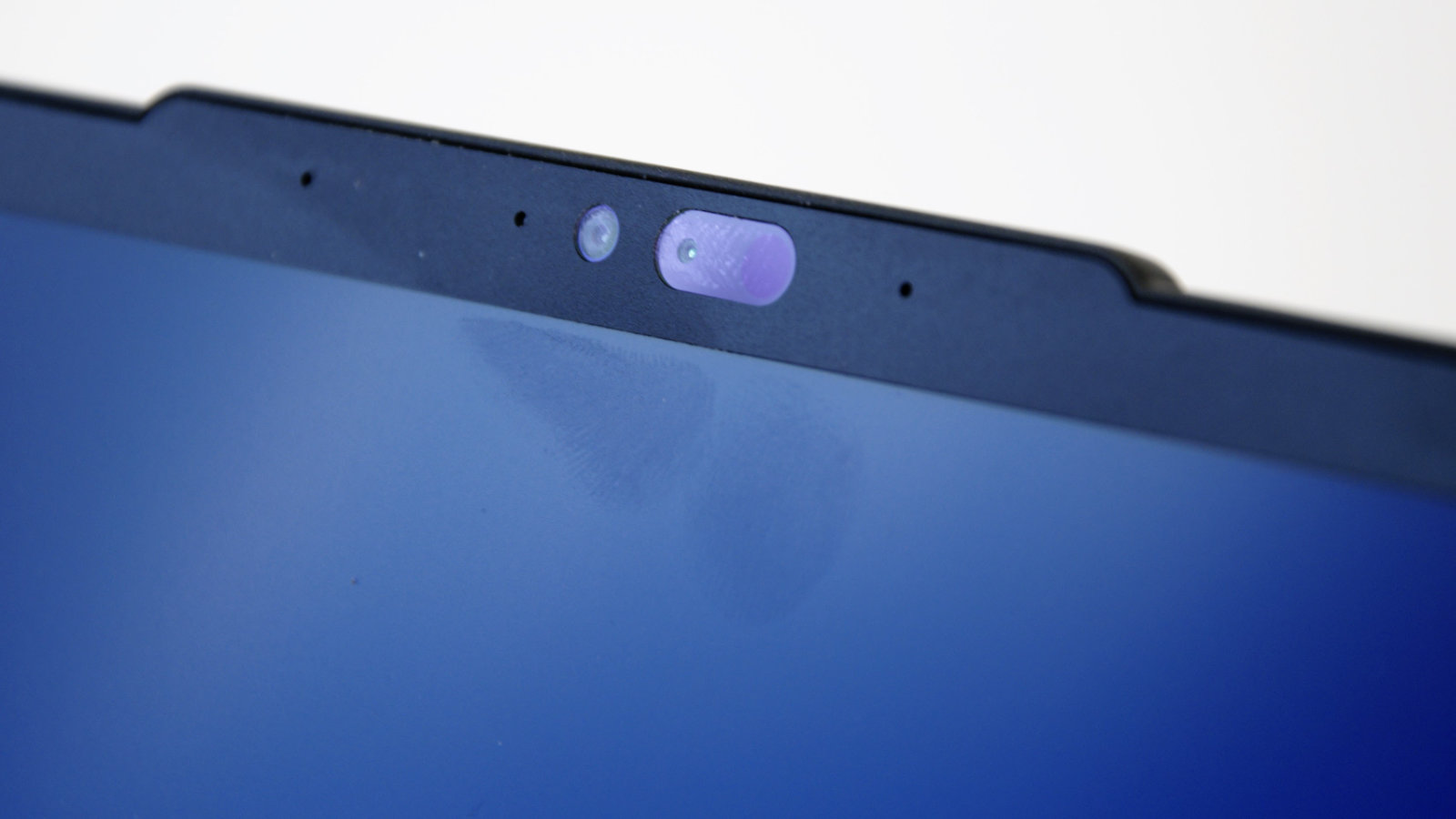
Where it suffered the most in comparison was in graphical tests and heavy processing problems like CineBench23. There is only offered a third or less of the processing power of a true x64 processor.
The lack of OpenCL hints that this machine won’t be a wonderful choice for occasional gaming or graphically intensive tasks.
One curiosity was the SSD speed, which on initial testing, looked acceptable for a PCIe 3.0 NVMe slot. Though, according to Lenovo specifications, and those for the SSST Model CL4 used in this machine, the port and the drive are PCIe 4.0 compliant. What we can only conclude is that the space on this M.2 2242 drive is insufficient space is available for the number of NAND modules needed to reach PCIe 4.0 bandwidth levels, even if the M.2 port might support that level of performance.
A security label stopped us from going inside to explore using an alternative SSD, but we are aware that getting access to the M.2 ports requires removing part of the cooling system.
Because this system is fanless, the internal cooling is extensive and not putting it back in contact with the hot parts of this hardware would be a major issue.
- Performance: 3 / 5
Lenovo ThinkPad X13s: Battery
- 28 hours quoted
- 19 hours or more in testing
While using emulation to run x86 and x64 applications, this machine was never going to win many performance races, but the Snapdragon ARM architecture was built from an ancestry where power efficiency had top priority.
The quoted 28 hours of runtime sounds like something of a stretch, and under our testing, we never got anywhere near that level.
As PCMark 10 battery test won’t work, we resorted to other means to test the machine for long periods of time using web surfing and video playback.
In a balanced mode with the level of brightness needed to watch videos, it still managed nearly 16 hours, which is very good. And turning the brightness down to 120 nits, as per the PCMark 10 battery test requirements, and using power efficiency settings extended that running time to closer to 20 hours.
I’m sure that by turning off various power-consuming features, it might be possible to get even longer and get through a third working day without a recharge.
While the battery life is wonderful, it is worth considering that with a faster system, it might take less time to do some intense computing tasks, reducing the need for such long battery life. But if the tasks are less demanding, this machine can keep going where others would be exhausted.
- Battery: 5 / 5
Apple’s transition to M1 wasn’t without a few hiccups, and shifting the Windows PC from its x86 roots is likely to be even more challenging.
That’s evident in the ThinkPad X13s, as while it runs very well with applications compiled for ARM-based Windows, it is more of a challenge to get legacy tools to work, and if they do function, they might not run very efficiently.
Therefore, this machine is ideal for those that run only recompiled applications and not legacy tools.
This machine also has a list of problems that have nothing to do with the Snapdragon processor, namely M.2 2242 drives, dual USB-C ports and soldered RAM modules.
But the biggest issue here is the price, which seems excessive.
When you consider that even the cheapest X13s is more expensive than the Apple iPad Pro, with the M2 processor and 512GB of storage, then that price is probably too high.
Lenovo ThinkPad X13s: Report card
| Value | Expensive for a relatively low-powered machine. | 3 / 5 |
| Design | The magnesium construction is classy, and the X13s is generally well-made. | 4 / 5 |
| Features | Dual USB ports assume a docking station, but all the classic signature ThinkPad features are here. | 4 / 5 |
| Performance | The Snapdragon processor is all about efficiency, and this shows in the limp benchmark scores. | 3 / 5 |
| Battery | Incredible battery life, but then that’s expected with a 7W processor. | 5/ 5 |
| Total | Good for general office tasks but not suited to more demanding jobs. | 3.9 / 5 |
Lenovo ThinkPad Z13?
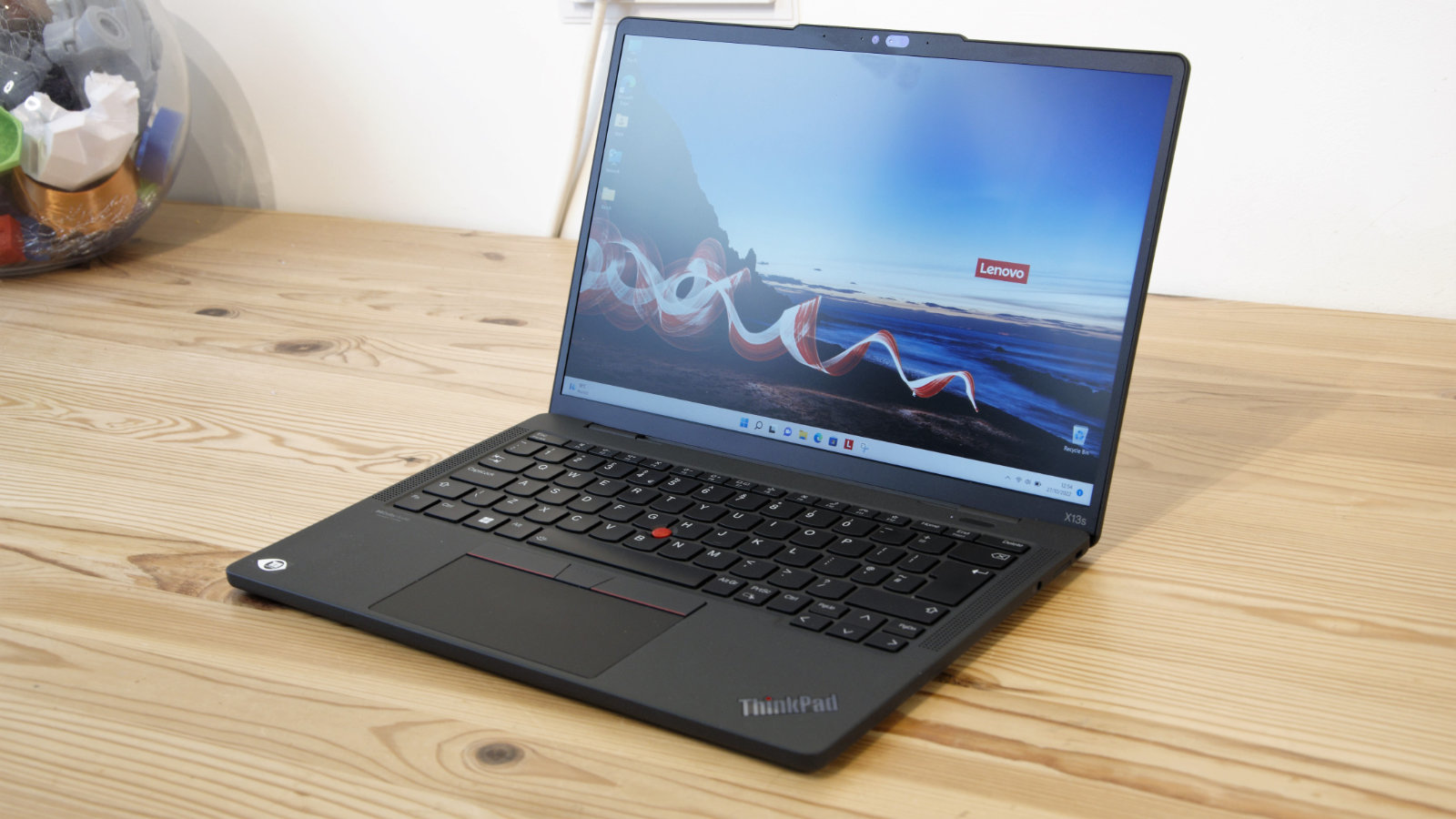
Buy it if...
If battery life is important
The Snapdragon processor in this machine allows it to run for a very long time and potentially span three days or use without charging. However, that power efficiency comes at a cost in terms of compatibility.
You run only Office apps
All the Microsoft applications will have been dual-compiled for ARM, making them run very smoothly on this version of Windows 11 Pro. But the same can’t be said for legacy applications that may not run at all.
You already have a USB docking station
Using this system with peripherals or an external screen demands a docking station and possibly some other equipment. The X13s requires a USB hub or docking station since the ports are USB-C 3.2 Gen 2.
Don't buy it if...
You use legacy apps
The emulation of the x86 and x64 processors isn’t perfect, and some other applications will not work. You need to check if an ARM recompiled version is available, or you might be out of luck.
Playing games or interactive 3D is a requirement
The Adreno GPU attached to the Snapdragon processor was designed for phone use, and therefore doesn’t have the power that a good integrated x86 GPU or discrete video card might offer on a gaming laptop.
It's your money
While a company might make the call that the battery life justifies the investment, paying this much for a machine that isn’t 100% PC compatible might be considered rash, if not excessive. Better value choices exist, even from Apple.
Also consider
Lenovo ThinkPad Z13
Even more expensive, but the power in this small laptop is significantly greater. It still suffers from having only two USB-C ports and soldered RAM, but the processing power available can handle very demanding tasks with ease.
Check out our Lenovo ThinkPad Z13 review
Asus ZenBook 13
Intel has been overtaken in performance and power efficiency in recent years by AMD, and the ZenBook 13 uses the AMD Ryzen 7 5800U and its Radeon Graphics to deliver an excellent mobile experience. It also sports an OLED screen and good performance.
Read more: Asus ZenBook 13 review
HP Elite Dragonfly G2
An 11th Gen CPU design that is highly portable and comes with a very high-quality screen. However, all the USB ports are on one side, and it isn’t the cheapest option. Hopefully, when the 12th Gen silicon refresh comes along, these might become cheaper.
Read our full HP Elite Dragonfly G2 review
Check out the latest Lenovo coupon codes.
Mark is an expert on 3D printers, drones and phones. He also covers storage, including SSDs, NAS drives and portable hard drives. He started writing in 1986 and has contributed to MicroMart, PC Format, 3D World, among others.

